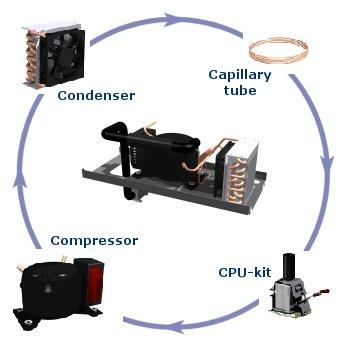After careful consideration I have decided to transfer all hardware review activities to a new domain. I purchased Hardwareasylum.com in 2012 and have been working hard to build a new and improved Ninjalane on that domain. If you are reading this you have reached one of the archived articles, news, projects and/or reviews that were left behind during the site migration.
Please update your bookmarks and be sure to visit the new and improved Ninjalane at Hardwareasylum.com
VapoChill Impressions
Author: Dennis Garcia
Published: Wednesday, March 05, 2003
Introduction
Introduction
There have been many reviews posted about how great the VapoChill phase change cooling system is but there is something that gets very little mention in any of the reviews that I've seen, the overall VapoChill package. This review won't really consist of amazing overclocks or how-to installations but rather will consist of what else you get besides a subzero processor cooling system.
A little background
asetek is a Denmark based company founded in 1997 by a small group of gamers who faced the challenge of building a faster computer. Since then asetek has become a world leader in vapor phase cooling solutions. Currently there is only a small number of companies that do this sort of thing and even a smaller number that can offer similar solutions to the consumer market.
So how do you build a faster computer? Unless you are actually building the processors and/or motherboards the only way to make a faster computer is to, well, make it go faster by overclocking. One of the typical issues with overclocking is that it generates more heat than normal causing a variety of problems including stability and decreased component lifetime. The vapor phase change cooling system by asetek removes some of those problems from the equation by allowing systems to run faster than ever before while producing less noise and increasing stability.
Some people may wonder what the heck phase change cooling is. The answer is quite simple and you might be surprised as to how common the process is. The air conditioning in your car uses phase change to provide cold air, your refrigerator and freezer both use phase changes for a similar purpose, those little cans of compressed air use a phase change to supply high-pressure air. Even the boiling water on your stove is a form of phase change cooling, just at a higher temperature.
The basics
The compressor starts up and compresses the refrigerant so it will become a liquid. Heat is generated during this process so the liquid will need to be cooled in the condenser (radiator) to remain a liquid. The refrigerant then moves down though a series of small tubes to further lower the pressure created during the compression process as it moves towards the evaporator. (At this time the refrigerant will be pretty close to room temperature.) The next step can be completed in one of two ways. You can either introduce heat to the liquid causing it to become a gas (not very efficient) or you can rapidly lower the pressure on the liquid causing it to quickly return to a gaseous state. Heat energy is consumed for this transformation to take place. That heat can either come from the surrounding air or in this case the processor.

The picture above is divided into 4 parts and each part opposite on the circle does completely opposite things. CPU supplies heat, condenser removes it. Compressor adds potential energy by compressing the gas into a liquid. The small capillary tubes are used to store that energy in liquid form as it travels back to the evaporator to be released.
Full system specs and dimensions can also be found on the asetek website, direct links will be provided at the conclusion of this article.

